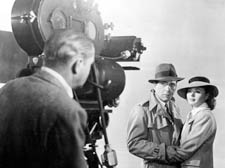|
|
 |
| |

Humphrey Bogart and Ingrid Bergman |
Candid camera: behind the scenes of the golden age of cinema stills
Drawing on a personal archive of 100,000 film stills and a life-long passion for the movies, Joel Finler is the perfect guide for a trip through the stars and stories of early cinema, writes Dan Carrier
Hollywood Movie Stills: Art and technique in the golden age of the studios
By Joel W Finler. Reynolds and Hearn £19.99
HANGING from a wobbly clock face high above a bustling city street while the cameras whirred is a career-defining moment for 1920s action hero Harold Lloyd. But while the comic star made his name with his real life stunts in such films as Safety Last, Lloyd came closest to losing his life when posing for a much more sedate shot.
The story of how he lost two fingers and had to take seven months out of his film-a-week schedule emerges in a new book by Belsize Park-based film historian Joel Finler.
Based on an archive of over 100,000 film stills and images, Mr Finler has written a comprehensive guide to cinematic still photography covering the golden age of movie making – the 1920s through to the 1960s.
The story goes like this: Lloyd was asked to pose for some publicity shots and had been handed a prop by a photographer to jazz up a promotional picture. It was a fake bomb with a fuse that could be lit.
But somehow the bomb had been muddled up with a real explosive device. When the fuse fizzled to the bottom without the shot being taken, Lloyd put it on the floor as he tried to put a new fuse in the top. It duly exploded and took a finger and thumb clean off, as well as temporarily blinding him. If he’d been holding the device, he would have been killed.
Such stories are the bread and butter of Mr Finler’s new book, and he is perfectly placed to tell them – as well as keeping his own, 100,000-plus collection of behind-the-scenes stills, he has studied film for the best part of 50 years.
Mr Finler came to London from a small town in Ohio in 1959. He had completed an economics degree and had applied to the London School of Economics for post graduate research. He didn’t get in, but a secretary at the Holborn university wrote him a kind letter suggesting he apply to the smaller and less well-known department at neighbouring University College London (UCL).
“It was a quirk of fate that was to change my life,” he says. He enrolled to study economics but was smitten by a new course in film at the Slade School of Art.
“I came to London when the film industry was on a cusp of a revolution,” he says. The industry was about to take another cultural shift as it was considered less as escapist entertainment and more for its cultural impact and significance.”
He swapped economics for film studies and then took on the role as the UCL’s college magazines film critic. It was this that was the start of a film stills archive. It gave him his first “in” to collecting behind the scenes images of studios.
“The film company used the stills to publicise their films,” he reveals. “I’d go to the press show and they’d hand over stills from films you wanted to review.”
He was particularly drawn to writing for the underground press – he was Time Out’s first film critic and worked for a number of other alternative 1960s publications. He made contacts at the British Film Institute and befriended indie cinema giant Andi Engel – the German film buff who moved to Camden and established the Renoir cinema in Bloomsbury and the successful art house film distribution company, Artificial Eye.
This gave him the further ways to extend his collection, which he now adds to by trawling through film auctions, internet sites and industry contacts.
“Film still photographers took lots of photographs on set and this means you also see scenes that you will not see when you go to the pictures,” he says.
“Some where taken in picture galleries but a lot more where taken on set. The galleries were usually for promotion”.
They include things that hit the cutting room floor and Mr Finler finds the new angles they give on films particularly fascinating: one includes the final scenes of Double Indemnity, the film of the hard-boiled James M Cain novella.
There is an execution scene, shocking in itself, which was catalogued by stills photographers but was taken out of the directors final cut. “They would also turn out a huge variety of other shots,” says Mr Finler. “As well as the stills photographer working on set, they would do a wide variety of other work, taking pictures of the director, stars and entire unit at work, and other behind-the-scenes or ‘candid’ views of the stars during breaks.
“They too would often be given assignments outside the film studio – to take photographs at the stars’ homes, favourite restaurants or nightspots and cover events such as premieres and awards ceremonies.
“In contrast to the idealised, timeless quality of the portraits – which were often heavily retouched – the more candid everyday photographs are of special interest for us today.”
Above all, the pictures capture a golden era of film greats.
“They are of historical interest as part of the extensive visual record documenting the styles and fashions of the times, the streets, houses and automobiles, the restaurants, nightclubs and cinemas in that tinsel town in sunny California,” says Mr Finler.
“In addition, for those interested in the development of the cinema, many of the production shots serve as a valuable record of film making.”
|
 |
|
 |
 |
|
 |
|



